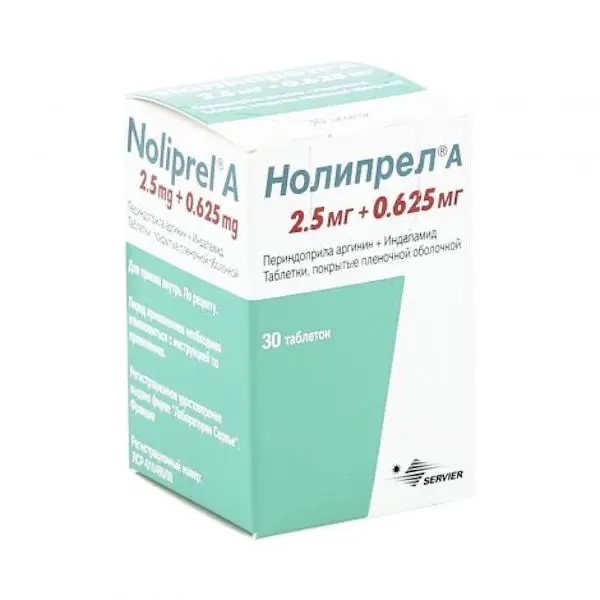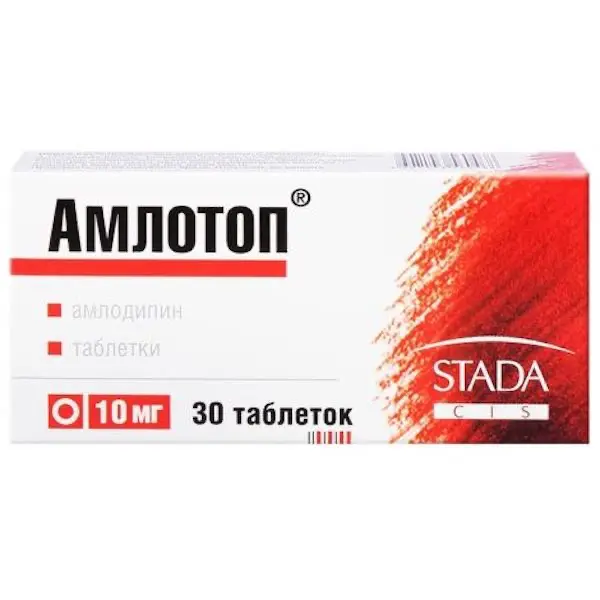Description
Noliprel A Pharmacodynamics
The medicinal product Noliprel A is a combined preparation containing indapamide and perindopril arginine. The pharmacological properties of the drug Noliprel A combine the individual properties of each of the components.
Mechanism of action
Noliprel A
The combination of perindopril and indapamide enhances the antihypertensive effect of each.
Indapamide
Indapamide belongs to the group of sulfonamides and has pharmacological properties similar to thiazide diuretics. Indapamide inhibits reabsorption of sodium ions in the cortical segment of the Genle loop, which leads to increased renal excretion of sodium ions, chlorine and, to a lesser extent, potassium and magnesium ions, thereby increasing diuresis and reducing blood pressure (BP).
Perindopril
Perindopril is an inhibitor of the enzyme that converts angiotensin to angiotensin II (angiotensin-converting enzyme (ACE) inhibitor. ACE, or kininase II, is an exopeptidase that both converts angiotensin to the vasoconstrictor angiotensin II and degrades bradykinin, which has a vasodilator effect, to an inactive heptapeptide.
As a result, perindopril:
Reduces aldosterone secretion; by negative feedback principle, increases plasma renin activity; with prolonged use, reduces total peripheral vascular resistance (PPR), which is mainly due to effects on vessels in the muscles and kidneys. These effects are not accompanied by retention of sodium ions and fluid or development of reflex tachycardia.
Perindopril normalizes myocardial function by reducing preload and postload. The study of hemodynamic parameters in patients with chronic heart failure (CHF) revealed:
decreased filling pressure in the left and right ventricles of the heart; decreased ROSS; increased cardiac output; and increased muscle peripheral blood flow.
Indications
Essential hypertension.
In patients with arterial hypertension and diabetes mellitus type 2 to reduce the risk of microvascular complications (from the kidneys) and macrovascular complications from cardiovascular disease.
Contraindications
Indapamide .
-High sensitivity to the active ingredient or any other sulfonamides.
-Severe renal impairment (creatinine clearance (CK) below 30 ml/min).
-Hypatic encephalopathy.
-Serious hepatic dysfunction.
-Hypokalemia.
Co-administration with non-antiarrhythmic drugs capable of causing polymorphic ventricular tachycardia of the “pirouette” type is not reasonable (see section “Interaction with other medicinal products”). Breast-feeding period (see section “Administration during pregnancy and breast-feeding”).
-Children under 18 years of age (effectiveness and safety have not been established).
Perindopril .
-Hypersensitivity to the active substance or any other ACE inhibitors.
-An history of angioedema (Quincke’s edema) against the background of other ACE inhibitors (see section “Special Precautions”).
-Hereditary/ idiopathic angioedema.
-Pregnancy and breastfeeding (see section “Administration during pregnancy and breastfeeding”).
Co-administration with aliskiren and medicinal products containing aliskiren in patients with diabetes mellitus and/or moderate or severe renal impairment (glomerular filtration rate (GFR) less than 60 ml/min/1,73 m body surface area) (see sections “Pharmacodynamics” and “Interaction with other medicinal products”).
-Combined use with angiotensin II receptor antagonists (ARA II) in patients with diabetic nephropathy (see section “Cautions”).
-Combination with valsartan + sacubitril (see sections “Interaction with other medicinal products” and “Cautionary Note”).
-Extracorporeal therapy leading to blood contact with negatively charged surfaces (see section “Interaction with other medicinal products”).
-Developed bilateral stenosis of the renal arteries or stenosis of the artery of the only functioning kidney (see section “Special indications”).
-Children under 18 years of age (efficacy and safety not established). Noliprel@A.
-High sensitivity to any of the excipients (see section “Composition”).
-Noliprel A should not be used in patients on hemodialysis or in patients with untreated decompensated heart failure due to insufficient clinical experience.
-Children under 18 years of age (efficacy and safety have not been established).
Lactase deficiency, galactosemia or glucose-galactose malabsorption syndrome (the drug contains lactose).
Dosage and administration
- Orally, preferably in the morning, before a meal.
- Essential hypertension.
- One tablet of the drug Noliprel@A once a day.
- If possible, administration of the drug is started with a selection of doses of single-component drugs. In case of clinical necessity, the possibility of prescription of combined therapy with Noliprel A immediately after monotherapy may be considered. In patients with arterial hypertension and diabetes mellitus type 2 to reduce the risk of microvascular complications (from kidney side) and macrovascular complications from cardiovascular diseases
1 tablet of the drug Noliprel@ A once a day. After 3 months of therapy, on condition of good tolerability, the dose may be increased up to 2 tablets of Noliprel A once daily (or 1 tablet of Noliprel@Aforte once daily). - Special patient groups
- Elderly patients
Always discontinue treatment after evaluation of renal function and blood pressure. Renal dysfunction
C Noliprel A is contraindicated in patients with severe renal impairment (CK values less than 30 ml/min). - In patients with moderate renal impairment (CKD 30-60 ml/min), it is recommended to start therapy with the required doses of drugs (as monotherapy) contained in Noliprel A.
- Patients with CK equal to or greater than 60 ml/min do not require dose adjustment. Regular monitoring of plasma creatinine and potassium concentrations is required during therapy.
- Impaired hepatic function (see sections “Contraindications”, “Special indications” and “Pharmacokinetics”)
- Noliprel A is contraindicated in patients with severe hepatic impairment.
- No dose adjustment is required in patients with moderate hepatic impairment.
- Children and adolescents
Noliprel A is contraindicated in children and adolescents under 18 years of age because of lack of data on safety and efficacy in patients of this age group.





